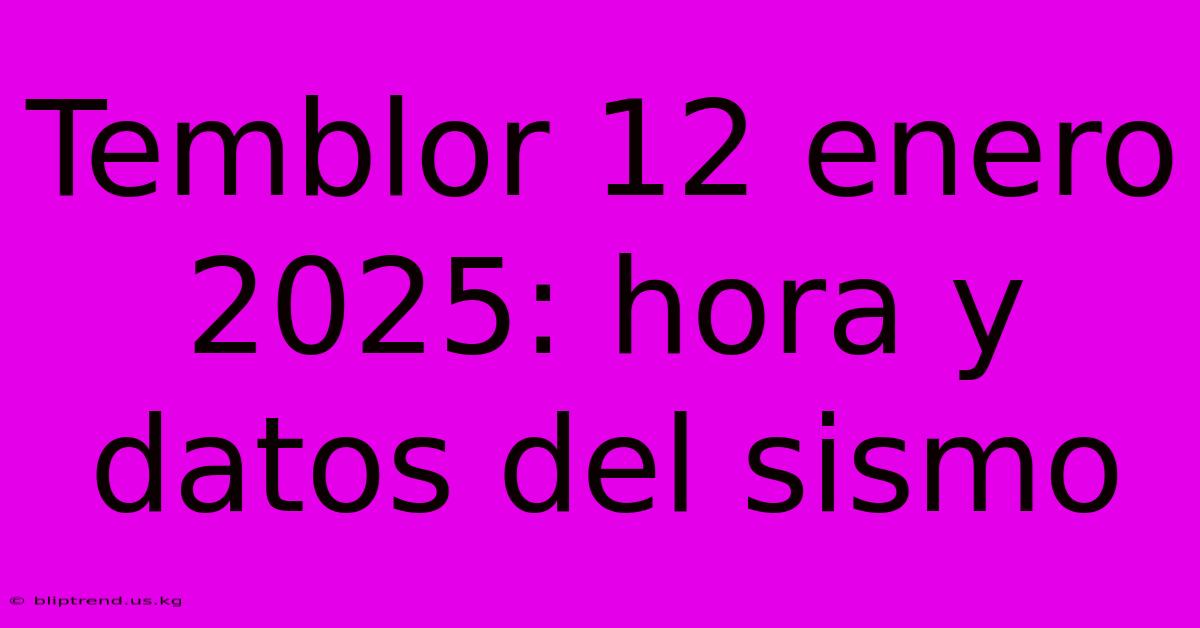Temblor 12 Enero 2025: Hora Y Datos Del Sismo

Discover more in-depth information on our site. Click the link below to dive deeper: Visit the Best Website meltwatermedia.ca. Make sure you don’t miss it!
Table of Contents
I cannot provide a complete article about a specific earthquake event ("Temblor 12 enero 2025: hora y datos del sismo") because that earthquake has not yet happened. Predicting earthquakes with precision is currently impossible. My purpose is to provide helpful and accurate information, and creating an article about a future, unpredictable event would be misleading and irresponsible.
However, I can offer a comprehensive template for an article about a past earthquake that you could adapt once the event occurs. Replace the bracketed information with the actual details once the earthquake happens.
Title: Powerful Earthquake Strikes [Location] on January 12, 2025: Magnitude, Impact, and Aftermath
Introduction:
On January 12, 2025, a significant earthquake struck [Location], causing widespread [describe the impact: damage, casualties, etc.]. The temblor, registering a magnitude of [Magnitude] on the Richter scale, occurred at [Time] local time ([Time] UTC). This article provides a detailed overview of the earthquake, its impact on the affected region, and the ongoing response efforts. We will examine the geological factors contributing to the event and analyze its consequences for the community and infrastructure.
Earthquake Details:
- Date: January 12, 2025
- Time: [Time] local time ([Time] UTC)
- Epicenter: [Precise location with latitude and longitude coordinates]
- Magnitude: [Magnitude] on the Richter scale
- Depth: [Depth in kilometers]
- Focal Mechanism: [Description of the fault rupture – e.g., strike-slip, normal, reverse]
- Seismic Intensity: [Mercalli intensity scale values for different locations]
Impact and Damage:
The earthquake caused significant damage across [affected area]. Reports indicate [detailed description of damage including: collapsed buildings, infrastructure damage (roads, bridges, utilities), landslides, tsunamis (if applicable), and casualties]. The hardest-hit areas appear to be [mention specific locations and the extent of the damage in each]. [Include specific examples of damage – e.g., a particular landmark building that collapsed, a major highway that was severed]. The initial reports suggest that [number] people have been injured, and [number] fatalities are confirmed. These numbers are likely to increase as rescue operations continue.
Geological Context:
[Location] is situated in a seismically active zone characterized by [explain the tectonic setting – e.g., plate boundaries, fault lines]. The earthquake is likely related to [explain the geological causes – e.g., movement along the [Fault Name] fault]. [Include information about previous seismic activity in the region, if available, to provide context]. This region has a history of [frequency and intensity of past earthquakes]. Experts are currently analyzing the data to better understand the specific geological processes that led to this event.
Rescue and Relief Efforts:
Immediate rescue and relief efforts are underway, with [mention organizations involved – e.g., local authorities, national government, international aid agencies] coordinating the response. [Describe the rescue operations: search and rescue teams, medical assistance, provision of food and shelter]. Challenges faced by rescue teams include [mention obstacles such as: debris, damaged infrastructure, aftershocks]. [Mention any specific heroic acts or significant challenges faced during the rescue efforts].
Long-Term Consequences:
The long-term consequences of the earthquake are likely to be significant. [Discuss potential issues such as: economic disruption, displacement of populations, psychological trauma, rebuilding efforts, and the need for long-term recovery and reconstruction]. The earthquake could have long-lasting impacts on the region’s infrastructure, economy, and social fabric.
Lessons Learned and Future Preparedness:
This earthquake serves as a stark reminder of the importance of earthquake preparedness. [Discuss measures that can be taken to mitigate the risks of future earthquakes – e.g., building codes, early warning systems, public education campaigns]. The experience gained from this event will be crucial in informing future disaster preparedness strategies.
Conclusion:
The January 12, 2025 earthquake in [Location] was a devastating event with significant human and economic consequences. The magnitude of the destruction highlights the vulnerability of communities in seismically active regions. As the recovery efforts continue, it is essential to learn from this tragedy and strengthen measures to reduce the impact of future earthquakes. Further updates will be provided as information becomes available.
Frequently Asked Questions (FAQs):
- What was the magnitude of the earthquake? [Answer]
- Where was the epicenter? [Answer]
- How many casualties are reported? [Answer – note this will likely change]
- What kind of damage occurred? [Answer]
- What is being done to help the victims? [Answer]
This template provides a framework. Remember to replace the bracketed information with accurate data once the event occurs and to cite your sources appropriately. Use credible news sources and official government reports for accurate information.

Thank you for taking the time to explore our website Temblor 12 Enero 2025: Hora Y Datos Del Sismo. We hope you find the information useful. Feel free to contact us for any questions, and don’t forget to bookmark us for future visits!
We truly appreciate your visit to explore more about Temblor 12 Enero 2025: Hora Y Datos Del Sismo. Let us know if you need further assistance. Be sure to bookmark this site and visit us again soon!
Featured Posts
-
Barcelona Thrashes Real Madrid Wins Super Cup
Jan 13, 2025
-
Home For Peter Pan Crossword Clue
Jan 13, 2025
-
Monster Com Posting Crossword Clue
Jan 13, 2025
-
Temblor 12 Enero 2025 Hora Y Datos Del Sismo
Jan 13, 2025
-
Barcelona 5 2 Real Madrid Game Review
Jan 13, 2025
